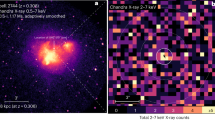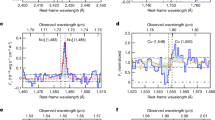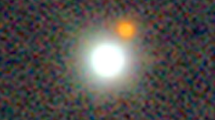Abstract
Primordial black holes (PBHs) have long been suggested as a viable candidate for the elusive dark matter. The abundance of such PBHs has been constrained using a number of astrophysical observations, except for a hitherto unexplored mass window of MPBH = [10−14, 10−9] solar masses. Here we carry out a dense-cadence, 7-hour-long observation of M31 with the Subaru Hyper Suprime-Cam (HSC) to search for microlensing of stars in M31 by PBHs lying in the halo regions of the Milky Way and M31. Given our simultaneous monitoring of tens of millions of stars in M31, if such light PBHs make up a significant fraction of dark matter, we expect to find many microlensing events. However, we identify only a single candidate event, which translates into stringent upper bounds on the abundance of PBHs in the mass range MPBH ≃ [10−11, 10−6] solar masses.
This is a preview of subscription content, access via your institution
Access options
Access Nature and 54 other Nature Portfolio journals
Get Nature+, our best-value online-access subscription
$29.99 / 30 days
cancel any time
Subscribe to this journal
Receive 12 digital issues and online access to articles
$119.00 per year
only $9.92 per issue
Buy this article
- Purchase on Springer Link
- Instant access to full article PDF
Prices may be subject to local taxes which are calculated during checkout





Similar content being viewed by others
Data availability
The catalogue of variability star candidates including the candidates shown in this paper is available from the corresponding author upon reasonable request.
References
Davis, M., Efstathiou, G., Frenk, C. S. & White, S. D. M. The evolution of large-scale structure in a universe dominated by cold dark matter. Astrophys. J. 292, 371–394 (1985).
Clowe, D. et al. A direct empirical proof of the existence of dark matter. Astrophys. J. Lett. 648, L109–L113 (2006).
Dodelson, S. & Liguori, M. Can cosmic structure form without dark matter? Phys. Rev. Lett. 97, 231301 (2006).
Jungman, G., Kamionkowski, M. & Griest, K. Supersymmetric dark matter. Phys. Rep. 267, 195–373 (1996).
Klasen, M., Pohl, M. & Sigl, G. Indirect and direct search for dark matter. Prog. Part. Nucl. Phys. 85, 1–32 (2015).
Zel’dovich, Y. B. & Novikov, I. D. The hypothesis of cores retarded during expansion and the hot cosmological model. Sov. Astron. 10, 602 (1967).
Hawking, S. Gravitationally collapsed objects of very low mass. Mon. Not. R. Astron. Soc. 152, 75–78 (1971).
Carr, B. J. & Hawking, S. W. Black holes in the early Universe. Mon. Not. R. Astron. Soc. 168, 399–416 (1974).
Carr, B., Kühnel, F. & Sandstad, M. Primordial black holes as dark matter. Phys. Rev. D 94, 083504 (2016).
Capela, F., Pshirkov, M. & Tinyakov, P. Constraints on primordial black holes as dark matter candidates from capture by neutron stars. Phys. Rev. D 87, 123524 (2013).
Lane, R. R. et al. Testing Newtonian gravity with AAOmega: mass-to-light profiles of four globular clusters. Mon. Not. R. Astron. Soc. 400, 917–923 (2009).
Paczynski, B. Gravitational microlensing by the galactic halo. Astrophys. J. 304, 1–5 (1986).
Griest, K. et al. Gravitational microlensing as a method of detecting disk dark matter and faint disk stars. Astrophys. J. Lett. 372, L79–L82 (1991).
Alcock, C. et al. The MACHO project: microlensing results from 5.7 years of Large Magellanic Cloud observations. Astrophys. J. 542, 281–307 (2000).
Tisserand, P. et al. Limits on the MACHO content of the galactic halo from the EROS-2 survey of the Magellanic clouds. Astron. Astrophys. 469, 387–404 (2007).
Sasaki, M., Suyama, T., Tanaka, T. & Yokoyama, S. Primordial black hole scenario for the gravitational-wave event GW150914. Phys. Rev. Lett. 117, 061101 (2016).
Ali-Haïmoud, Y., Kovetz, E. D. & Kamionkowski, M. The merger rate of primordial-black-hole binaries. Phys. Rev. D 96, 123523 (2017).
Griest, K., Cieplak, A. M. & Lehner, M. J. Experimental limits on primordial black hole dark matter from the first 2 yr of Kepler data. Astrophys. J. 786, 158–167 (2014).
Miyazaki, S. et al. Hyper Suprime-Cam: system design and verification of image quality. Publ. Astron. Soc. Jpn 70, S1 (2018).
Aihara, H. et al. First data release of the Hyper Suprime-Cam Subaru strategic program. Publ. Astron. Soc. Jpn 70, S8 (2018).
Klypin, A., Zhao, H. & Somerville, R. S. ΛCDM-based models for the Milky Way and M31. I. Dynamical models. Astrophys. J. 573, 597–613 (2002).
Aihara, H. et al. The Hyper Suprime-Cam SSP Survey: overview and survey design. Publ. Astron. Soc. Jpn 70, S4 (2018).
Crotts, A. P. S. M31—a unique laboratory for gravitational microlensing. Astrophys. J. Lett. 399, L43–L46 (1992).
Baillon, P., Bouquet, A., Giraud-Heraud, Y. & Kaplan, J. Detection of brown dwarfs by the microlensing of unresolved stars. Astron. Astrophys. 277, 1–9 (1993).
Gould, A. Theory of pixel lensing. Astrophys. J. 470, 201–210 (1996).
Calchi Novati, S. Pixel lensing. Microlensing towards M31. Gen. Relat. Grav. 42, 2101–2126 (2010).
Aurière, M. et al. A short-timescale candidate microlensing event in the POINT-AGAPE pixel lensing survey of M31. Astrophys. J. Lett. 553, L137–L140 (2001).
Alard, C. & Lupton, R. H. A method for optimal image subtraction. Astrophys. J. 503, 325–331 (1998).
Bosch, J. et al. The Hyper Suprime-Cam software pipeline. Publ. Astron. Soc. Jpn 70, S5 (2018).
Williams, B. F. et al. The Panchromatic Hubble Andromeda Treasury. X. Ultraviolet to infrared photometry of 117 million equidistant stars. Astrophys. J. Suppl. S. 215, 9–42 (2014).
Dalcanton, J. J. et al. The Panchromatic Hubble Andromeda Treasury. Astrophys. J. Suppl. S. 200, 18 (2012).
Huang, S. et al. Characterization and photometric performance of the Hyper Suprime-Cam software pipeline. Publ. Astron. Soc. Jpn 70, S6 (2018).
Witt, H. J. & Mao, S. Can lensed stars be regarded as pointlike for microlensing by MACHOs? Astrophys. J. 430, 505–510 (1994).
Gould, A. Femtolensing of gamma-ray bursters. Astrophys. J. Lett. 386, L5–L7 (1992).
Nakamura, T. T. Gravitational lensing of gravitational waves from inspiraling binaries by a point mass lens. Phys. Rev. Lett. 80, 1138–1141 (1998).
Musco, I., Miller, J. C. & Polnarev, A. G. Primordial black hole formation in the radiative era: investigation of the critical nature of the collapse. Class. Quantum Gravity 26, 235001 (2009).
Kühnel, F., Rampf, C. & Sandstad, M. Effects of critical collapse on primordial black-hole mass spectra. Eur. Phys. J. C 76, 93 (2016).
Kawasaki, M., Mukaida, K. & Yanagida, T. T. Simple cosmological solution to the Higgs field instability problem in chaotic inflation and the formation of primordial black holes. Phys. Rev. D 94, 063509 (2016).
Kawasaki, M., Kusenko, A., Tada, Y. & Yanagida, T. T. Primordial black holes as dark matter in supergravity inflation models. Phys. Rev. D 94, 083523 (2016).
Inomata, K., Kawasaki, M., Mukaida, K., Tada, Y. & Yanagida, T. T. Inflationary primordial black holes for the LIGO gravitational wave events and pulsar timing array experiments. Phys. Rev. D 95, 123510 (2017).
Kühnel, F. & Freese, K. Constraints on primordial black holes with extended mass functions. Phys. Rev. D 95, 083508 (2017).
Inomata, K., Kawasaki, M., Mukaida, K., Tada, Y. & Yanagida, T. T. Inflationary primordial black holes as all dark matter. Phys. Rev. D 96, 043504 (2017).
Carr, B., Raidal, M., Tenkanen, T., Vaskonen, V. & Veermäe, H. Primordial black hole constraints for extended mass functions. Phys. Rev. D 96, 023514 (2017).
Carr, B. J., Kohri, K., Sendouda, Y. & Yokoyama, J. New cosmological constraints on primordial black holes. Phys. Rev. D 81, 104019 (2010).
Barnacka, A., Glicenstein, J.-F. & Moderski, R. New constraints on primordial black holes abundance from femtolensing of gamma-ray bursts. Phys. Rev. D 86, 043001 (2012).
Ali-Haïmoud, Y. & Kamionkowski, M. Cosmic microwave background limits on accreting primordial black holes. Phys. Rev. D 95, 043534 (2017).
Ricotti, M., Ostriker, J. P. & Mack, K. J. Effect of primordial black holes on the cosmic microwave background and cosmological parameter estimates. Astrophys. J. 680, 829–845 (2008).
Alcock, C. et al. The MACHO project first-year Large Magellanic Cloud results: the microlensing rate and the nature of the galactic dark halo. Astrophys. J. 461, 84–103 (1996).
Kerins, E. et al. Theory of pixel lensing towards M31: I. The density contribution and mass of MACHOs. Mon. Not. R. Astron. Soc. 323, 13–33 (2001).
Riffeser, A., Fliri, J., Seitz, S. & Bender, R. Microlensing toward crowded fields: theory and applications to M31. Astrophys. J. Suppl. Ser. 163, 225–269 (2006).
Cieplak, A. M. & Griest, K. Improved theoretical predictions of microlensing rates for the detection of primordial black hole dark matter. Astrophys. J. 767, 145–154 (2013).
Navarro, J. F., Frenk, C. S. & White, S. D. M. A universal density profile from hierarchical clustering. Astrophys. J. 490, 493–508 (1997).
Gondolo, P. Optical depth evaluation in pixel microlensing. Astrophys. J. Lett. 510, L29–L32 (1999).
Ivezić, Z. et al. LSST: from science drivers to reference design and anticipated data products. Preprint at https://arxiv.org/abs/0805.2366v1 (2008).
Axelrod, T., Kantor, J., Lupton, R. H. & Pierfederici, F. Software and Cyberinfrastructure for Astronomy, an open source application framework for astronomical imaging pipelines. Proc. SPIE 7740, 774015 (2010).
Jurić, M. et al. The LSST data management system. Preprint at https://arxiv.org/abs/1512.07914 (2015).
Bertin, E. in Astronomical Data Analysis Software and Systems XX (eds. Evans, I. N. et al.) 435 (ASP Conf. Ser. 442, Astronomical Society of the Pacific, 2011).
Schlafly, E. F. et al. Photometric calibration of the first 1.5 years of the Pan-STARRS1 survey. Astrophys. J. 756, 158–171 (2012).
Tonry, J. L. et al. The Pan-STARRS1 photometric system. Astrophys. J. 750, 99–112 (2012).
Magnier, E. A. et al. The Pan-STARRS1 photometric reference ladder, release 12.01. Astrophys. J. Suppl. Ser. 205, 20–32 (2013).
Alard, C. Image subtraction using a space-varying kernel. Astron. Astrophys. Suppl. Ser. 144, 363–370 (2000).
Mandelbaum, R. et al. The third gravitational lensing accuracy testing (GREAT3) challenge handbook. Astrophys. J. Suppl. Ser. 212, 5–33 (2014).
Rowe, B. T. P. et al. GALSIM: the modular galaxy image simulation toolkit. Astron. Comput. 10, 121–150 (2015).
North, J. R. et al. The radius and mass of the subgiant star β Hyi from interferometry and asteroseismology. Mon. Not. R. Astron. Soc. 380, L80–L83 (2007).
de Jong, J. T. A. et al. MACHOs in M31? Absence of evidence but not evidence of absence. Astron. Astrophys. 446, 855–875 (2006).
Takahashi, R. & Nakamura, T. Wave effects in the gravitational lensing of gravitational waves from chirping binaries. Astrophys. J. 595, 1039–1051 (2003).
Katz, A., Kopp, J., Sibiryakov, S. & Xue, W. Femtolensing by dark matter revisited. J. Cosmol. Astropart. Phys. 12, 005 (2018).
Green, A. M. Microlensing and dynamical constraints on primordial black hole dark matter with an extended mass function. Phys. Rev. D 94, 063530 (2016).
Acknowledgements
We thank S. Blinnikov, A. Gould, B. Jain, M. Kawasaki, A. Kusenko, C.-H. Lee, H. Murayama, D. Spergel and M. Tanaka for discussion. We thank N. Kaiser and M. Sasaki for pointing out the importance of wave optics effect in our microlensing constraints when M.T. gave a talk at the seminar of YITP, Kyoto University. This work was supported by the World Premier International Research Center Initiative (WPI Initiative), MEXT, Japan, by the FIRST programme ‘Subaru Measurements of Images and Redshifts (SuMIRe)’, CSTP, Japan, Grant-in-Aid for Scientific Research from the JSPS Promotion of Science (23340061, 26610058 and 15H03654), MEXT Grant-in-Aid for Scientific Research on Innovative Areas (15H05887, 15H05892, 15H05893 and 15K21733) and the JSPS Program for Advancing Strategic International Networks to Accelerate the Circulation of Talented Researchers. The HSC collaboration includes the astronomical communities of Japan and Taiwan, and Princeton University. The HSC instrumentation and software were developed by the National Astronomical Observatory of Japan (NAOJ), the Kavli Institute for the Physics and Mathematics of the Universe (Kavli IPMU), the University of Tokyo, the High Energy Accelerator Research Organization (KEK), the Academia Sinica Institute for Astronomy and Astrophysics in Taiwan (ASIAA), and Princeton University. Funding was contributed by the FIRST programme from Japanese Cabinet Office, the Ministry of Education, Culture, Sports, Science and Technology (MEXT), the Japan Society for the Promotion of Science (JSPS), Japan Science and Technology Agency (JST), the Toray Science Foundation, NAOJ, Kavli IPMU, KEK, ASIAA and Princeton University. The Pan-STARRS1 Surveys (PS1) were made possible through contributions of the Institute for Astronomy, the University of Hawaii, the Pan-STARRS Project Office, the Max-Planck Society and its participating institutes, the Max Planck Institute for Astronomy, Heidelberg and the Max Planck Institute for Extraterrestrial Physics, Garching, The Johns Hopkins University, Durham University, the University of Edinburgh, Queen’s University Belfast, the Harvard-Smithsonian Center for Astrophysics, the Las Cumbres Observatory Global Telescope Network Incorporated, the National Central University of Taiwan, the Space Telescope Science Institute, the National Aeronautics and Space Administration under grant no. NNX08AR22G issued through the Planetary Science Division of the NASA Science Mission Directorate, the National Science Foundation under grant no. AST-1238877, the University of Maryland and Eötvös Loránd University (ELTE). Results are based in part on data collected at the Subaru Telescope and retrieved from the HSC data archive system, which is operated by Subaru Telescope and Astronomy Data Center at NAOJ. This paper makes use of software developed for the LSST. We thank the LSST Project for making their code available as free software at http://dm.lsstcorp.org.
Author information
Authors and Affiliations
Contributions
All the authors discussed the results and commented on the manuscript. M.T., H.N. and S.M. wrote the paper. H.N. performed most of the data analysis, the calculation of microlensing event rates and the model fitting. M.T. proposed the idea. M.T and T.S. prepared the observation plan and strategy for the HSC/Subaru observation of M31. N.Y. and R.H.L. provided advice about the use of the HSC data analysis pipeline, especially the image difference method. T.K. and S.S. carefully estimated the effect of finite-source size and the wave optics effect on microlensing event rates for PBH at ≲10−9M⊙, and we were able to obtain a more accurate estimation of the upper bounds on the abundance of such PBHs. All the authors commented on the draft text.
Corresponding authors
Ethics declarations
Competing interests
The authors declare no competing interests.
Additional information
Journal peer review information: Nature Astronomy thanks Bernard Carr and Florian Kuhnel for their contribution to the peer review of this work.
Publisher’s note: Springer Nature remains neutral with regard to jurisdictional claims in published maps and institutional affiliations.
Supplementary information
Supplementary Information
Supplementary Figures 1–19, Supplementary Tables 1–2, Supplementary References 1–14
Rights and permissions
About this article
Cite this article
Niikura, H., Takada, M., Yasuda, N. et al. Microlensing constraints on primordial black holes with Subaru/HSC Andromeda observations. Nat Astron 3, 524–534 (2019). https://doi.org/10.1038/s41550-019-0723-1
Received:
Accepted:
Published:
Issue Date:
DOI: https://doi.org/10.1038/s41550-019-0723-1
This article is cited by
-
Superradiant leptogenesis
Journal of High Energy Physics (2024)
-
Gravitational waves from phase transitions in scale invariant models
Journal of High Energy Physics (2024)
-
Primordial black holes as dark matter: interferometric tests of phase transition origin
Journal of High Energy Physics (2024)
-
Role of QCD in moduli stabilization during inflation and axion dark matter
Journal of High Energy Physics (2023)
-
Binary collisions of dark matter blobs
Journal of High Energy Physics (2023)



